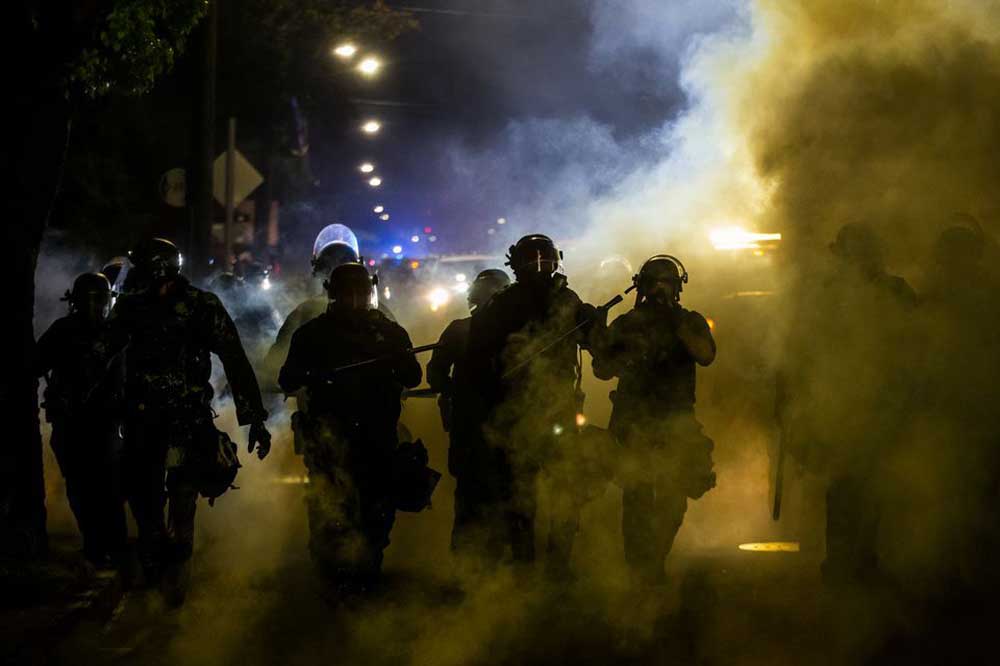Portland 2020 protests: Police relied too much on tear gas, rubber-ball grenades, outside review finds
Published 3:40 pm Thursday, August 10, 2023

- Police are enveloped in smoke and tear gas as they march east on Stark St. adjacent to Ventura Park. Protests continued for the 101st consecutive night as a group of demonstrators gathered in Ventura Park in Southeast Portland on Saturday, Sept. 5, 2020. Police declared a riot just after 9 p.m. after three Molotov cocktails were thrown in their direction. Marches continued around the area, periodically being met with police action and arrests, until early Sunday morning. Dave Killen/Staff
Portland police relied too heavily on tear gas, projectiles, hand-thrown rubber-ball explosives and other distraction devices that harmed peaceful people in the crowd during 2020’s social justice protests and riots, outside examiners found.
The Police Bureau “must strengthen its policies, command training and resources to ensure that this never happens again,” the investigators with Independent Monitor said in a 95-page analysis released Thursday.
Trending
The outside assessment of police crowd control tactics and training was one among a series of remedies required by the U.S. Department of Justice for the city to meet terms of a 2014 settlement agreement on officer use of force.
A Justice Department critique of Portland police two years ago faulted officers for inappropriate force and said police failed to adequately document or review the more than 6,000 times officers used force during the city’s mass protests after the killing in May 2020 of George Floyd by Minneapolis police.
Consultant Nicholas E. Mitchell, who now oversees the Los Angeles police and sheriff’s departments as an independent monitor, and his team found little oversight of the Police Bureau’s now-defunct specialized crowd control Rapid Response Team, with police brass largely deferring to team members about policing tactics and offering little to no review or critique of its training.
This allowed the team to “operate in the shadows,” the report found.
Further, officers across the bureau didn’t receive adequate direction from supervisors on the ground rules of their “engagements” before they started crowd control assignments. Some supervisors provided detailed briefings while others gave “cursory” instructions, the review found.
This led to inconsistent rules on how police should determine whether a demonstrator’s conduct was acceptable or should lead to arrest, according to the report.
Trending
“When the rules of engagement fluctuate night to night without explanation, they seem arbitrary and cause the public to doubt the logic and legitimacy of the department’s response,” the report said.
The review found the bureau’s authorized use of rubber-ball grenades or hand-thrown explosive devices that project rubber balls to disperse crowds “overly permissive,” noting that the manufacturer of the rubber-ball grenades used by the bureau warns that they can result in serious injury and should be “reserved as a last selection” when chemical agents and less-lethal impact rounds have proven ineffective.
The evaluators criticized the lack of a steady presence by the police chief or his high-level command staff in the field during months of the nightly protests, which left officers feeling “alone and unsupported by upper command,” thecity-commissioned analysis said.
‘Six months of chaos’
While the “six months of chaos on Portland’s streets” left residents feeling “alienated” and “furious” with police tactics, officers also felt betrayed, targeted with rocks, bricks and in some cases, Molotov cocktails thrown at them, the report said. Many officers believed Portland’s elected leaders failed to publicly distinguish between peaceful protesters and those who took to the street to engage in violence, the report said.
The Police Bureau should have assigned more plainclothes officers to observe the crowds and had more video of what was transpiring on the street to help command staff make prudent tactical decisions, they found.
The evaluators said they were shocked by the “near total lack of video downtown in 2020” from stationary or mobile video cameras, other than cellphone videos, that they said hindered police investigations of excessive force by officers as well as protesters’ “riotous behavior.” The lack of video also “blinded the command post,” they said.
They recommended state law be changed to allow for temporary use of pole-mounted cameras to obtain video coverage of any future civil disorder.
City lawyers had interpreted state law based on a state court decision to restrict police from maintaining live video feeds of the protests because doing so would involve collecting “information” about protest crowds, which are “political activities” not directly related to an ongoing criminal investigation.
In July 2020, a Multnomah County judge issued a temporary restraining order barring the city and police from collecting or maintaining video or audio of protesters in public spaces, except if it is related to a criminal investigation. That followed a lawsuit filed by the ACLU of Oregon challenging the bureau’s live streaming of protests.
While the Police Bureau placed plainclothes officers in crowds through what it called “Echo Squad” in November 2020, there were no standard operating procedures governing the squad, the report found.
Police must adopt “guardrails to ensure that this power is never abused” and should not use such plainclothes officers in crowds absent a specific “articulable threat of violence or serious disorder,” the report said.
Since the Rapid Response Team disbanded, the Police Bureau’s reliance on mobile field force officers drawn from across the bureau isn’t ideal, the analysis said.
These officers typically receive only two days of initial training and infrequent refresher instruction and have had limited opportunity to practice drills together, the report said.
“A reliance on officers with minimal public order training in one of the most active protest cities in the nation is simply insufficient to protect Portland and its residents,” the evaluators concluded.
The need for a specialized public order policing team is “as acute now as ever,” the report said.
A new unit must be shaped by tighter policies, better training and more rigorous oversight, the evaluators said. They also recommended the city create a “Public Order Citizens’ Academy” to educate residents on police tactics.
“The public must not again be surprised by a PPB public order team’s policies, tactics, practices and munitions,” the examiners said.
The approximately 50 officers, detectives and sergeants of the Rapid Response Team resigned en masse in June 2021, a day after a team member was indicted, accused of fourth-degree assault stemming from a baton strike against a protester. The officer charged ended up apologizing to the woman he struck in a videotaped public message and a judge dismissed the assault case.
Other recommendations include: Updating police directives to specifically prohibit the use of rubber-ball grenades for public order, though state law now does so, and restricting use of officer baton pushes against members of a crowd to “very limited circumstances.”
The analysis also said police must improve tracking of munitions in their inventory and how officers use them; must train officers to narrate their decision-making for using force into their body-worn cameras at the end of their shifts; provide officers sufficient time to complete their use-of-force reports; and rebuild what is now a fractured mutual aid network to ensure the bureau can rely on help from area police agencies for major events.
The examiners also recommended that thepolice chief and his top assistants be visible to officers during large-scale protests and train no less than six supervisors to serve as incident commanders.
The city has agreed to adopt the report’s recommendations. Independent Monitor has agreed to review city progress in 180 days.
An online community forum on the report will be held at 6 p.m. Aug. 23.








